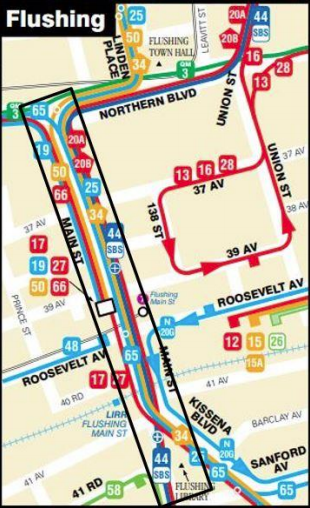Mayor de Blasio — who recently caved to a car-loving local pol and delayed the final phase of the much-needed Queens Boulevard safety redesign — has another test on his hands in Queens.
In June, the mayor announced that the city would create a busway on Main Street in Flushing by banning cars from a .3-mile stretch of the car-choked road, from Northern Boulevard to Sanford Avenue and Kissena Boulevard.
The busway, modeled after the successful 14th Street pilot in Manhattan, would help thousands of daily bus riders who use Main Street as a transfer route to other transit options. Buses have become even more important for workers as the city has reopened after the pandemic, which is why the MTA wrote to de Blasio last month demanding that he create 60 miles of busways.
But, in a shortsighted move, some local business leaders and the Flushing Business Improvement District have organized to protest the proposal, saying a busway would hurt their businesses. That, however, has not been the experience of businesses along 14th Street which, despite some grumbling, were doing just fine before the pandemic. They were learning what businesses in car-free city centers in Europe have known for decades — that foot traffic for stores and restaurants increases when space-hogging, polluting cars are banished.
De Blasio would be wise to stand with the beleaguered Queens residents and stay the course on the Main Street busway. It’s a matter of basic equity and social justice.
Creating and maintaining safe, affordable, and accessible transportation options has always been a fight in New York City — and in Queens transit riders, cyclists and pedestrians always seem to be fighting for scraps because of the fealty paid by our leaders to car drivers.
In that way, the mayor’s cave on the final phase of the Queens Boulevard safety redesign was depressing, but not surprising. In February, when Council Member Karen Koslowitz of Forest Hills advocated for delaying the redesign to consider an already dismissed maneuver to save more space for drivers, the mayor said, “What’s the harm of giving it a look?”
The harm is the potential lives lost. The delay advocated by Koslowitz not only puts our children and neighbors in harm’s way, but is effectively playing politics with human lives. That is another year of danger for drivers, pedestrians and cyclists. The constant genuflection of the current administration to those unversed and uninterested in improving transportation for everyone has a measurable cost. It is one consistently felt in Queens.
It’s the same story with the Main Street busway. Anyone who has tried to take a bus through Flushing knows the struggle. Choked by car traffic, buses crawled through Main Street, which is second in congestion only to Times Square. Ridership of Queens buses already has rebounded quite a bit from pandemic troughs, and car traffic is already slowing those buses down: Borough-wide, speeds that had risen to 10.8 miles per hour have dropped to 9.8 miles per hour, or 9.2 percent. (The buses that run on Main Street are notoriously slower than the borough-wide average.) Advocates should not have to fight tooth and nail, clawing tiny concessions from an intractable bureaucracy to have common-sense transit solutions. Immediately upon seeing the success of 14th Street, we should have seen it replicated across all boroughs.
In some parts of Queens, it's a 20-minute walk to a subway stop. Buses are irregular, which is why so many residents feel forced to get a car. Eastern Queens is essentially held hostage by neglect and car culture.
It’s essential to increase bus frequency and routes with emphasis on guaranteeing all-door boarding, building more dedicated busways, and ensuring accessibility for all riders. These are low-cost fixes that would make an enormous difference in my life and the lives of my neighbors.
Mayor de Blasio and the leaders of Queens must stop leaving Queens behind.
Mel Gagarin (@MelforProgress) is a former candidate for Congress in Queens and a community organizer.








